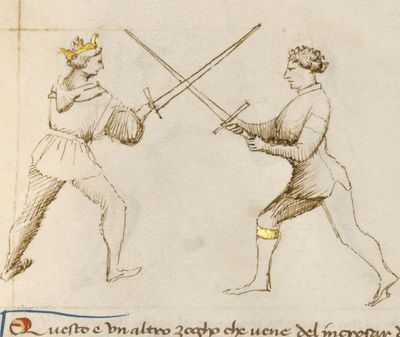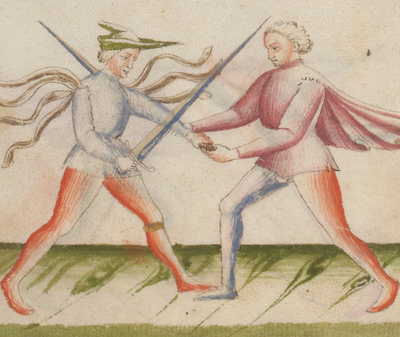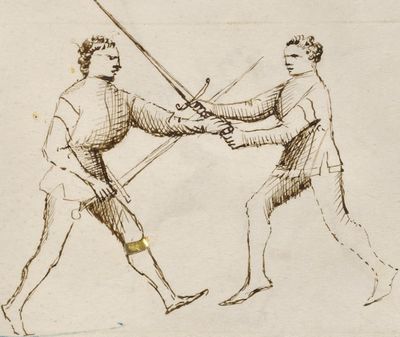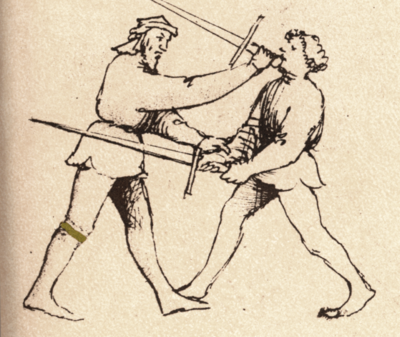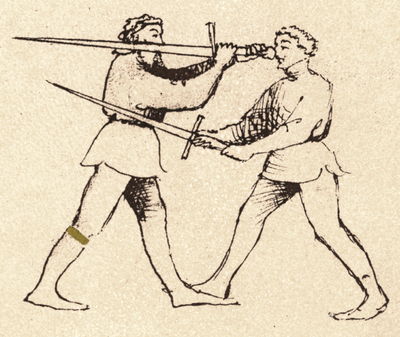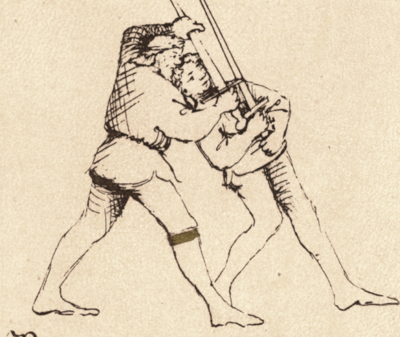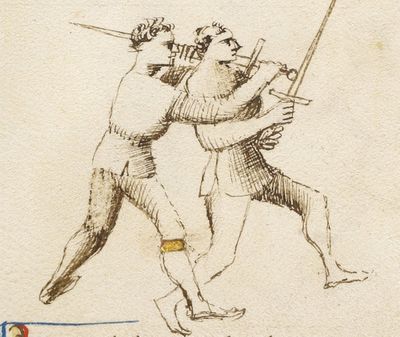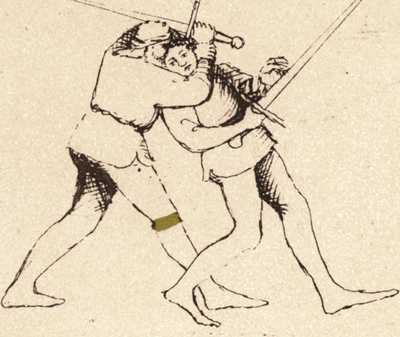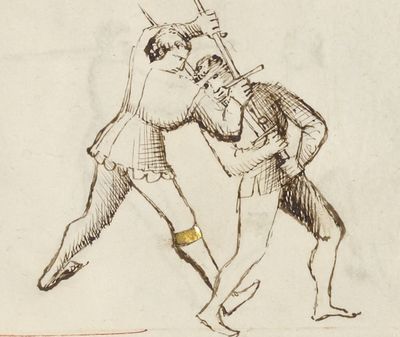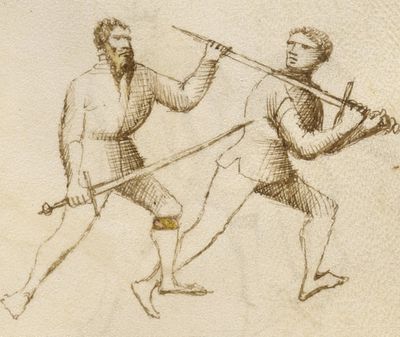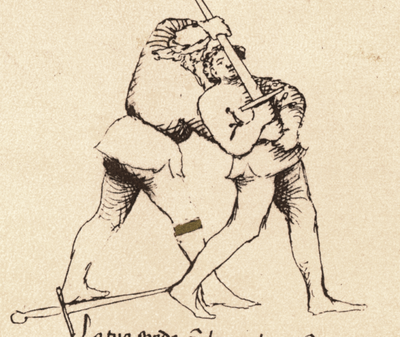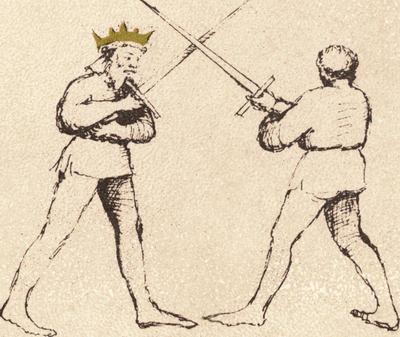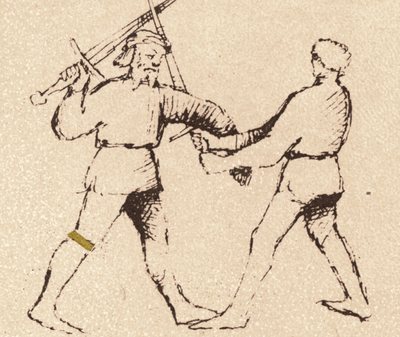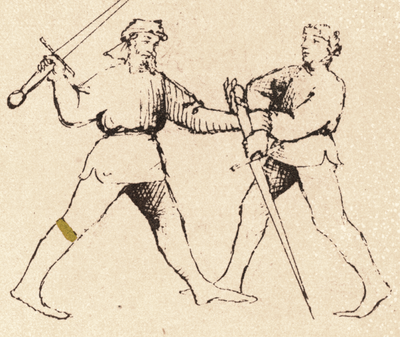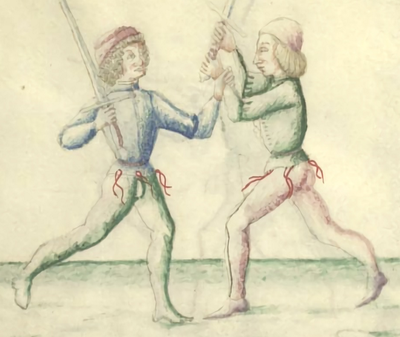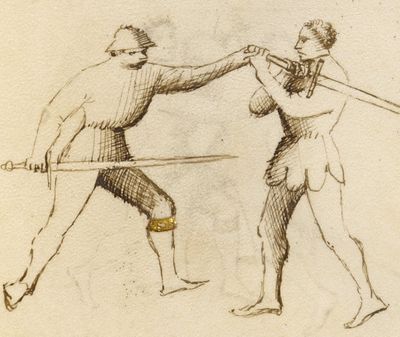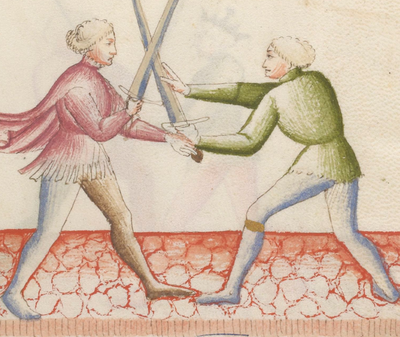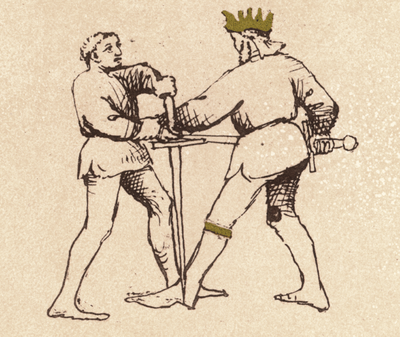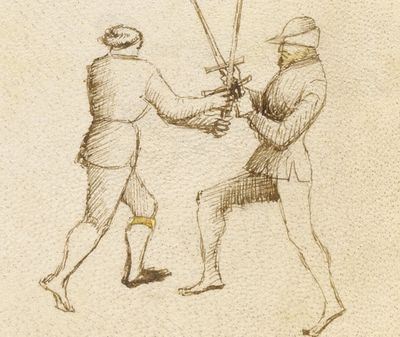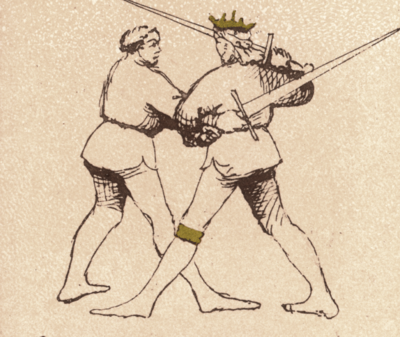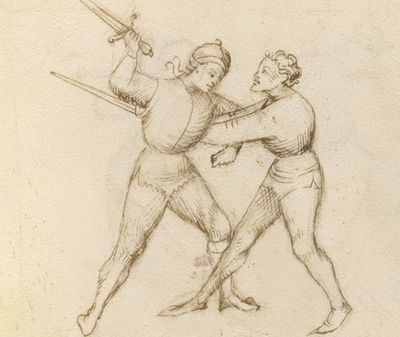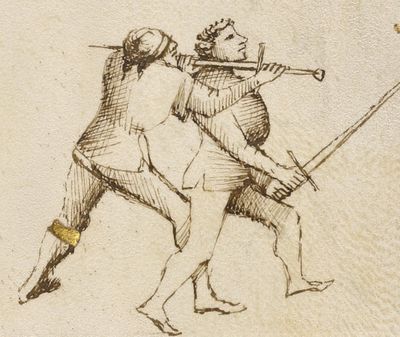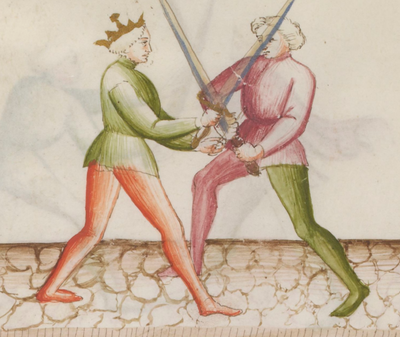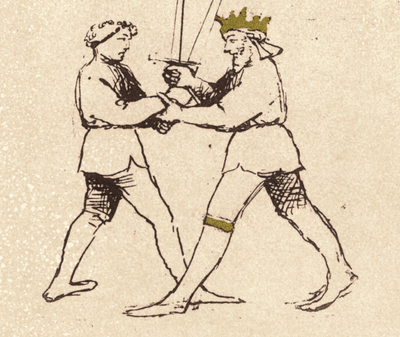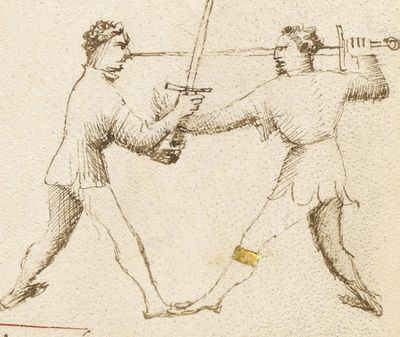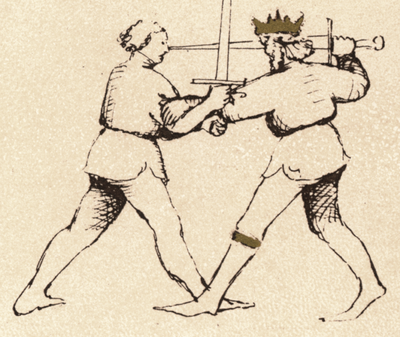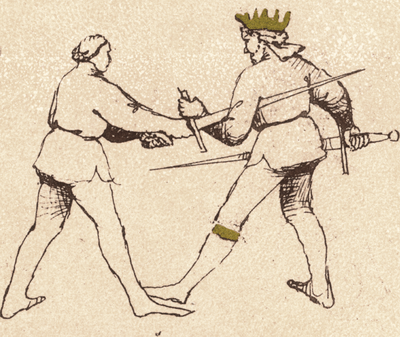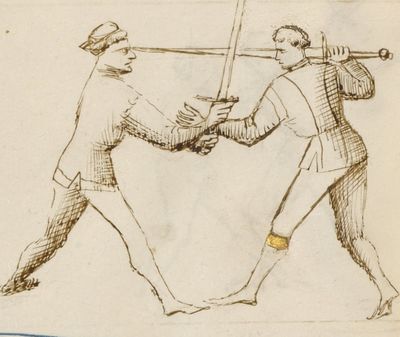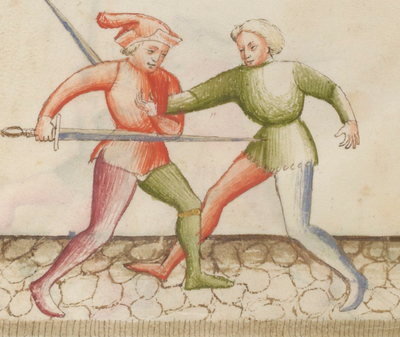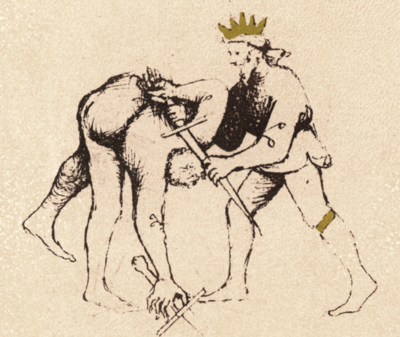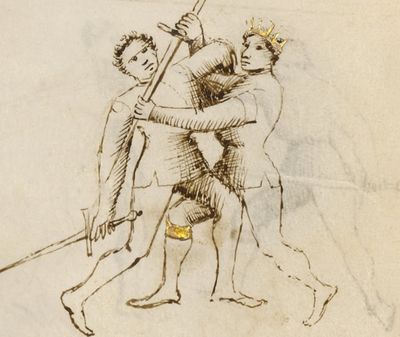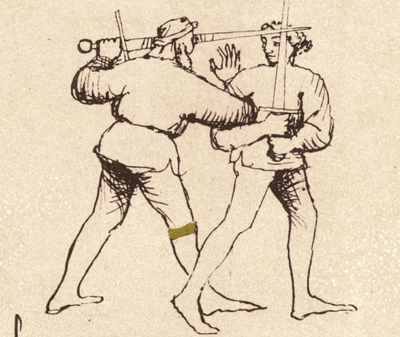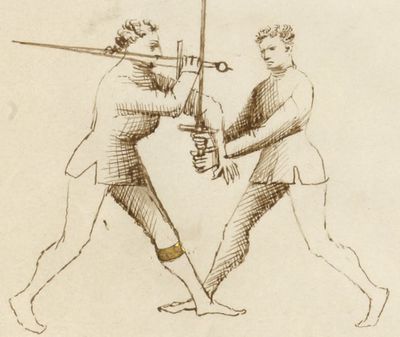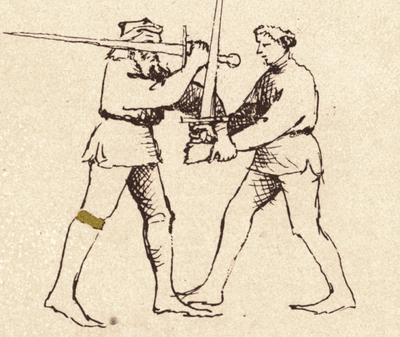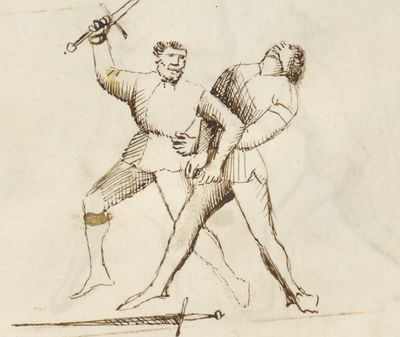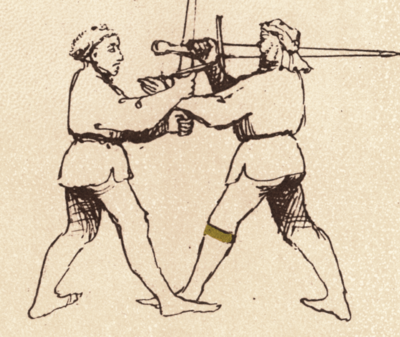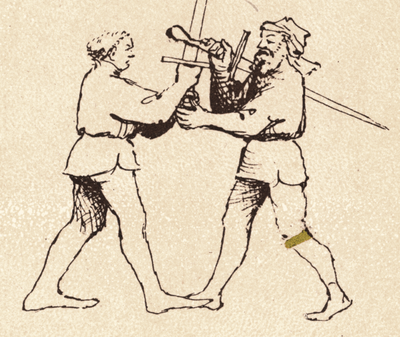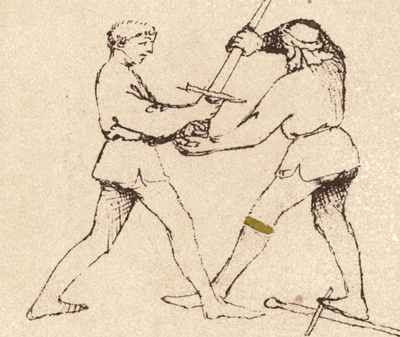|
|
You are not currently logged in. Are you accessing the unsecure (http) portal? Click here to switch to the secure portal. |
Fiore de'i Liberi/Sword in Two Hands/Narrow Play
Illustrations |
Illustrations |
Novati Translation |
Paris Translation |
Morgan Transcription (1400s) |
Getty Transcription (1400s) |
Pisani Dossi Transcription (1409) |
Paris Transcription (1420s) |
|---|---|---|---|---|---|---|---|
| [No Image] | [48] Here we begin the Narrow Play of the two handed sword, in which you will see all manner of covers, strikes, locks, dislocations, sword disarms and throws to the ground. There will also be the remedies and the counters needed for each situation, whether you are attacking or defending. |
Here begins the play of the sword in two hands, the narrow play, the method of breaking all thrusts and cuts, in the which will be every method of covering, striking, and binding, and dislocations, and grapples, and takings of the sword, and beating to the ground in diverse ways. And there will be remedies and counters of every category that should offend or defend. |
[16r-t] E qui comenza zogo de spada a doi mane, zogo stretto. E'l modo de rompe tute punte e tagli. In lo quale serano d'ogni rasone, coverte, feride, e ligadure, e dislogadure, e prese, e tore de spada, e sbatere in terra, per diversi modi. E serano gli remedii, e gli contrarii de zaschuna rasone che bisogna a offendere e difendere. |
[27v-d] ¶ Qui cominza zogho de spada a doii man zogo stretto, in lo quale sara d'ogni rasone coverte, e feride e'ligadure. e dislogadure e prese, e tore de spade, e sbatter in terra per diversi modi. E sarano gli rimedii e gli contrarii de zaschuna rasone che bisogna a offender e a defender. |
|||
[49] Because of the way that we stand here crossed, We stand with crossed swords, and from this crossing either one of us can make all of the plays that follow. And as I told you earlier, these plays will follow one after the other. [In the Pisani Dossi, the Scholar is wearing a crown.] |
We stand here crossed and from this crossing that we make, all the plays that follow us can be made, and by one of us as easily as the other. And all of these plays will follow, one after the other, as was previously said. [In the Morgan, the Scholar is wearing a crown.] |
[16r-a] Nui stasemo qui incrosadi e di questo incrosare che noii fazemo. Tuti gli zoghi che noii segueno fargle possemo. Acosi uno de noii, quale l'altro. E tuti gli zoghi seguirano uno l'altro como denanci e dito. |
[28r-a] ¶ Noi stasemo qui incrosadi, e di questo incrosar che noii fazemo, tutti gli zoghi che noii segueno far gli possemo, chosi uno di noii quale l'altro. E tutti gli zoghi seguirano l'uno l'altro come denançi e ditto. |
[22a-a] Per modo che noii stasemo aqui incrosadi |
|||
[50] Because of your hilt which I hold in my hand, Using the crossing my Master made with his right foot forward, I now complete the first play as follows: I pass forward with my left foot, and I reach over my right arm with my left hand, seizing his sword-grip in the middle, between his hands. And from here I can strike him with either my edge or my point. This grip can be made when fighting with the two-handed sword or the one-handed sword. And I can make this grip by reaching either under or over the crossed swords. |
I would strike, and I will hold your sword; restrained by no From the crossing that the Master has made with his right foot forward, I complete the first play—that is, I step with my left foot and I pass my left hand over my [right] arm and grasp the hilt of his sword in between his hands (in the middle of the hilt), and then I could strike with edge and point. And this catch can be made as easily with the sword in one hand as with the sword in two hands, and this catch can be made as easily crossing under the hands as over. [In the Paris, the Scholar's sword is in front of his arm.] |
[16r-b] Per lo incrosar che a fatto lo magistro cum lo pe dritto denanci io comprischo lo primo zogo, zoe che io passo cum lo pe stancho, e cum la mia mane stancha passo di sopra lo mio dritto brazo, e piglo lo suo mantenir dela spada sua, in mezo le soe[!] mane zoe in mezo delo mantenir. E cum taio e punta, Io lo posso ferir, e questa presa se po fare cosi a spada de una mane, come a doe mane, e cosi a incrosar de sotto mane come di sopra se po far tal presa. |
[28r-b] ¶ Per lo incrosare ch'a fatto lo magistro, cum lo pe dritto denanci io complisco lo primo zogho, zoe Che io passo cum lo pe stancho e cum la mia mane stancha passo di sopra lo mio dritto brazzo, e piglo el suo mantenir di'sua spada in mezo le soe[!] mane zoe in mezo delo mantenir. E cum taglo e punta io lo posso ferir. E questa presa si po fare a spada d'una e de doii mane. & a incrosare tanto di sopra quanto di sotta mane si po far tal presa. |
[22a-b] Per lo mantiger[!] tuo che in man io tegno |
[26r-c] ¶ Percutiam nulloque tuum prohibente tenebo | ||
[51] Because my sword has received a blow This is another play that flows from the crossing of my Master. And from that crossing I can make this play and all of the others that follow. In this play I grip my opponent at the elbow as shown, and then strike him in the face with the pommel of my sword. After that I can also strike him in the head with a downward strike before he has a chance to make cover against me. |
I strike to your face using this hilt, obviously ferocious. This is another play that comes from the crossing of my Master, and as he is crossed, he can make this play and the others that follow after—that is, he can make or grasp the player in this way to strike him in the face with the pommel of his sword. Also, he can strike him in the head with a downward blow before [the player] could make a cover ready. |
[16r-c] Questo e uno altro zogo che vene delo incrosar dello mio magistro. E como ello e incrosado ello po fare questo zogo e lli altri po che segueno de dredo, zoe ch'ello po fare overo piglare lo çugadore a questo modo, e ferirlo in lo volto cum lo pomo de sua spada. Anchora po ferirlo de fendente in la testa. Innanci ch'ello fare coverta presta. |
[28r-c] ¶ Questo e un altro zogho che vene del incrosar del mio magistro. E commo ello e incrosado ello po fare questo zogo e'gl'altri che qui dredo siegueno. zoe, Che'lo zugadore po pigliare a questo modo lo zugadore, e ferirlo in lo volto cum lo pomo dela spada sua. Anchora po ferirlo de fendente in la testa, inançi ch'ello possa fare coverta presta. |
[22a-c] Per la mia spada che a'recevudo colpo |
[26v-a] ¶ Hoc capulo vultum ferio tibi nempe feroci. | ||
[52] This is another strike with my pommel, This is another pommel strike, which is effective against a man with or without armor. Make this strike quickly if his face is unprotected, and you will certainly hurt him. I can tell you from experience that with this strike you’ll have him spitting out four teeth. From here, if you wish, you can also throw your sword around his neck, as my fellow student will show you next. |
This second blow is striking the companion in return using the hilt, This is another strike of the pommel and it can be done quickly; if his face is uncovered then do it without fear, because it may be done armored or unarmored. You will bore four teeth from his mouth with this play (as has been proven), and if you wanted, you could throw the sword to his neck as does the Scholar who is after me. |
[16r-d] Questo e uno altro ferir de pomo e se po far subito, se lo volto e discoverto fallo senza dubito, Che lo se po fare armado e disarmado. Quatro denti fora butta de boccha a uno cum tale zogo, che l'a provado. E lla spada se volesse al collo te poria butar come fa dredo da mi quello scolaro. |
[28r-d] ¶ Questo e un'altro ferir de pomo. E se po far subito Si lo volto a discoverto, fa lo senza dubito. Che ello si po fare armado e disarmado. Quatro denti butta Fior[!] di bocha a uno cum tal zogo, si ch'el l'a provado. E la spada al collo se volesse te poria butare, como fa dredo a'mi quello scolare. |
[22a-d] Aquesto e un altro ferir de mio pomo |
[26v-c] ¶ Ictus hic est alter capulo referire sodalem / | ||
[53] I send you to the ground in this match; As the student who preceded me told you, after doing the previous play I now put the sword-edge into your neck. And from here, if I discover that you have no neck armor, I will easily cut your throat. |
I, the great one, throw you to the ground, you anticipating something, From the play that came before me and as the Scholar has said, I have placed my sword at your neck and I could cut your throat well because I feel that you do not have an armored collar. [The Morgan and Paris resemble the Getty, but the Scholar's right foot is inside of (behind) his opponent's right foot.] |
[16v-a] Per lo zogo che m'e denanci, e como lo scolar ha ditto io t'o posta la spada al collo. E lla gola te posso ben taglar. Per o ch'io sento che tu non ai punto di colaro. |
[28v-a] ¶ Per lo zogho che m'e denanzi e como lo scolar a ditto io t'o posta la spada al collo, e la gola te posso ben taglare, per che i sento che tu non hai punto de colare. |
[22b-a] Io te mando in terra a'questo partito |
[27r-c] ¶ Te iacio in terram mango / quem precipis / actu | ||
[54] From the right cover I have caught you so well, |
A covering more on the right foretells when I will catch [you] by the throat; This play is made in this fashion: that is, that one goes with a middle blow against a middle blow to his left side, and then quickly goes to the narrow with a cover. He throws his sword to the neck of his companion, at the same time grasping his right hand with his left (as you see depicted here). He can then throw him to the ground without fail, thrusting his right foot behind [the player's] right. |
[15r-c] Questo zogo se fa per tal modo zoe che uno vada cum lo colpo mezano contra lo mezano de parte riversa e subito vada cum coverta ale strette. E buta la sua spada alo collo dello compagno, piglando la sua mane dritta cum la sua stancha de si in stesso come aqui dipento. Butarlo po in terra senza falimento metendo lo suo pe dritto dredo lo suo dritto. |
[22b-c] Per drita coverta io t'o cussi ben preso |
[30r-a] ¶ Dexterior tectura monet / ut gutture prendam. | |||
[55] This play is performed as follows: against a crosswise strike from his left, you meet it with a crosswise strike of your own from your left.[2] Then you quickly move to close range under cover, and then throw your sword around your opponent’s neck, as you see drawn here. From here you can easily throw him to the ground. [In the Pisani Dossi MS, the Scholar's right foot is outside (in front) of his opponent's right foot.] |
During a similar play, we bring you down into the deep earth. This is another catch to throw someone to the ground, sword and all—that is, that this Scholar crosses with the player on the right side and steps into the narrow; he pinches the right elbow of the player with his left hand, and then quickly he throws his sword to [the player's] neck, grasping his own sword at the middle (his right foot behind the right of the player). In this way, he throws [the player] to the ground with little honor. |
[15r-d] Questa e una altra presa de butar uno in terra cum tuta la spada. Zoe che aquesto scolar incrosa cum lo zugadore della parte dritta e passa ale strete, e cum la mane sua stancha penze lo cubitto dritto del zugadore. E subito gle butta la spada al collo piglando la sua propia spada al mezo. Ello suo dritto pe dredo lo suo dritto dello zugadore. Acosi lo butta[3] in terra cum pocho honore. |
[30r-b] ¶ Questo zogho se fa per tal modo zoe che uno vada cum lo colpo mezano contra lo mezano de parte riversa e subito vada cum coverta ale strette, e butti la spada al collo del compagno como qui e depento. Buttar lo po in terra senzo fallimento. |
||||
[56] If he covers from his right side, seize his sword with your left hand as shown and strike him with a thrust or a cut. Then after striking him hard, if you wish, you can drop your own sword and cut his face or neck with his own sword, in the manner shown by the student in the next picture.[5] |
This is another method of throwing someone to the ground, and it is done in this fashion: the Scholar crosses with the player on the right side and comes to the narrow. He grasps the sword of the player with his left hand (passing the middle of the sword), … [Text accompanies subsequent image.] |
[15v-a] Questo e uno altro modo de butar uno in terra. E si fa per tal modo lo scolar se incrosa cum lo zugadore dela parte dritta, e si vene ale strette. E cum la mane stancha pigla la spada delo zugadore passando la mezamento della spada, e subito butta la sua spada in terra, e quella del zugadore propia, gle mette al collo piglando lo mantenir al mezo zoe in mezo de la mane del zugadore. E cum lo suo pe dritto dredo lo suo dritto, e per tal modo lo butar in terra cum la sua spada propria. |
[29r-d] ¶ Se uno se covra dela parte dritta, piglia cum la tua mane stancha la sua spada per questo modo, e fierilo di punta voii cum lo taglio. E se tu voii tu gli tagli cum la sua spada lo volto o voii lo collo per lo modo ch'e depinto. Anchora quando io t'o ben ferido, io posso abandonar la mia spada e pigliar la tua per lo modo che fa lo scolaro che m'e di dredo. |
||||
[57] I have in hand the catch that I have sought with you Following on from the play of the student before me, I cut my opponent’s face with his own sword, then force him to the ground. Here I am demonstrating just how effective this art really is. |
I undertake with my hands the special taking for a …and immediately he throws his sword to the ground and thrusts the player's own sword to his neck, grasping the hilt in the middle—that is, between the hands of the player—with his right foot behind [the player's] right. And in this fashion he throws him to the ground with his own sword. |
[29v-a] ¶ Del zogho del scolaro che m'e denanzi, si fazo questo zogho, cum la sua spada gli taglio Lo volto mandandolo in terra. Ben ti mostraro che tal arte sia vera. |
[22b-b] In mane ho la presa che tegho o'cerchada |
[30v-a] ¶ Accipio manibus capturam tempore longo | |||
[58] This is the cover of the backhand |
[23b-a] Questa e coverta de la riverssa mano |
||||||
[59] From the cover of the backhand have I enclosed you here: |
[23b-b] Per la coverta de la riverssa mano aqui t'o aserato |
||||||
[60] This is a strong catch that comes from the backhand: |
[23b-c] Questa e una forte presa che ven de man riverssa |
||||||
[61] If he covers from his left side, grab his left hand including his pommel with your left hand, and pull it upwards and backwards. From there you will be able to strike him with thrusts and cuts. |
[29r-c] ¶ Se uno se covra dela parte riversa, pigla cum la sua mane stancha cum la sua man stancha cum tutto lu pomo dela sua spada, e penzilo in dredo, e cum punta e taglio ben lo po ferire. |
||||||
[62] |
In order for you to be able to overthrow my sword, with the left hand [This Master appears to be missing his crown.] |
[28r-b] ¶ Ut mihi tu posses ensem convellere leva | |||||
[63] In this fashion I have bound you so well If I am crossed at Narrow Play with someone, I can quickly make this move[6] to prevent him from attacking me by taking my sword, or a lock. |
This is another counter against the taking of the sword, and it can be made readily and quickly in this fashion. When one comes to cross with you and steps or advances close with his left foot forward, then grasp his hand at the wrist with your left hand (from under his hilt) and turn his sword toward your left side in such fashion as is depicted here. And thus you strike him in the chest, or in the belly, or wherever he likes least. |
[16v-d] Questo si e uno altro contrario che contra lo tore de spada e fe[!] fa presto e subito per tale modo. Quando uno si vene tego a incrosare, o passa, o acrese stretto cum lo pe stancho denanci, e la tua mane stancha pigla la sua mane in la zuntura della sua mane per sotto lo so mantenir. E volta la sua spada in verso parte riversa per tale modo ch'e aqui dipento. E si lo fieri in lo petto, o in lo ventre o vero li che meio[!] gle piase. |
[30r-a] ¶ Se io incroso ale strette cum uno. Subito fazo questa presa, per che ne cum tor di spada ne cum ligadure non mi faza offesa. Anchora lo posso ferire de punta e de taglio senza mio periculo. |
[23a-c] Per questo modo e t'o ben ligado |
|||
[64] When I am crossed I move to the Narrow Game, and I place the hilt of my sword between your two hands. Then I push your two hands upwards so that your sword is high. From here I throw my left arm over your arms from the left, binding[7] them with your sword pinned under my left arm. Then I will strike multiple times until I am exhausted. The student who follows me will show you what happens next. |
[28v-d] ¶ Quando io son incrosado io vegno al zogho stretto. Ello elzo de la mia spada enfra le toii mane metto. E levo le toii brazze cum la tua spada in erto. Ello mio brazo stancho butero per sopra li toii a man riversa, e serero li toii brazi cum la tua spada sotto lo mio brazzo mancho. E de ferir non ti lassaro in fin che saro stancho. Lo zogo che m'e dredo che fa lo scolaro. Ello e mio zogo, e quello te voglio fare. |
||||||
[65] I locked your arms with my left arm, The student who is before me has completed the play which I said to do. Your arms have been bound in ligadura mezana (middle bind). Your sword is prisoner, and it can not help you. And with mine I can cause you a lot of injuries. Without doubt I can put my sword to your neck. I can immediately do the play which is after me. |
[29r-a] ¶ Del scolaro che m'e denançi io complisco'l zogho. e quello che luii di far a ditto io l'o fatto. Le braze t'o ligade in ligadura mezana. La tua spada e in prisone e non ti po iutare. E cum la mia feride asaii te posso fare. La mia spada ti posso metter al collo senza dubito. El zogo che m'e dredo te posso far subito. |
[23a-a] Toii braçi cum lo mio stancho sono seradi |
|||||
[66] This play follows on from the previous one, where the student struck his opponent multiple times while using his left arm to keep the opponent’s arms and sword pinned. Now I throw my sword at my opponent’s neck as depicted. Then I throw him to the ground to complete the play. |
[29r-b] ¶ Del zogho che denançi si fa questo zogho, che quando lo scolaro a ben ferido lo zugadore tegnando gli brazzi cum la spada ben ligadi cum lo suo brazzo mancho la sua spada gli buta al collo e metilo in questo partito. Se io lo butto in terra lo zogho o complito. |
||||||
[67] I have locked your hand with my sword, |
On my sword I enclose the palm. You, miserable, also endure many wounds |
[23a-d] Serata t'o la mane cum mia spada |
[28v-a] ¶ Ense meo clausi palmam. tu vertice tandem | ||||
[68] I have hindered your sword with my arm, When I am crossed, I pass with a cover, and I injure you in your arms in this part. And this thrust you get in the face. And if I advance the left foot, both your arms will be bound. Or, that in the other play after me of grabbing you, you are bound at the sword by the hilt's retention. |
From the crossed swords I pass with cover and bind[9] your arms as shown, then I thrust my sword into your face. And if I advance the left foot forward I can bind both your arms. Or alternately I can do the play shown next, where I bind your sword by gripping your cross-guard.[10] [In the Paris, the Master is missing his crown. In the Morgan and Paris, the Master has his hand in position but hasn't grabbed his opponent's arm.] |
[16v-b] Quando io sono incrosado io passo cum coverta E fiero in gli toii brazi a questo partito. E questa punta pogno in lo to[!] volto. E si lo pe stancho io acresco trambe le brazi ti ligaro. Overo che in questo zogo che m'e dredo te pigliro zoe che te ligaro la spada, e per l'elzo la tegnero. |
[28v-b] ¶ Quando io son incrosado io passo cum coverta, e fiero in gli toii brazzi in questo partito. E questa punta ti metto in lo volto. E si lo pe stancho io acresco trambe le brazze te ligaro. Overo che in questo zogho che m'e dredo ti pigliro, zoe che ti ligaro la spada e per l'elço la tigniro. |
[22b-d] La tua spada cum lo mio braco o intardada |
|||
[69] I have trapped your sword by the hilt, This is the grip that the student before me said to do to you. I can injure you without danger. I retain your sword's hilt, I will give you cuts and thrusts cheaply (with no risk?). And this play breaks all sword-disarms, and doing it immediately spoils the narrow play. [In the Getty, the Master is missing his crown.] |
I, the very strong, seize your sword in the cross[ing]. Here I am making the bind that the previous student told you about, and from this position I can strike you with impunity. I have your sword bound by its cross-guard, and from here I can strike you with both cuts and thrusts. In addition, if done quickly this play can defeat all attempts to take my sword, and if it is done quickly enough it will defeat the opponent’s Narrow Game. [In the Paris, the Master is missing his crown.] |
[16v-c] La presa che dise lo scolar che m'e denanci quella ti fazo, ferir te posso senza impazo e tegno l'elzo de tua spada, de punte e tagli ti faro derada. E questo zogo rompe ogni tore de spada e llo zogo stretto subito farlo quello guasta. |
[23a-b] La tua spada per l'elço si o inpresonada |
[27r-b] ¶ In cruce prevalidus proprui tibi carpo mucronem. | |||
[70] This play is taken from the first play of the First Dagger Remedy Master, who places his left hand over the opponent’s wrist[12] to take the dagger from his hand. In similar fashion the student here places his left hand over the opponent’s right forearm, rotating it outwards to remove the sword from his right hand…[13] |
Using the sword to strike back, I become acquainted with your very own shoulder, |
[29v-b] ¶ Questo zogho e tolto del zogho dela daga çoe del primo magistro rimedio, che come ello mette la mane stancha sotto la daga per torgella de mane, per lo simile questo scolaro gli mette la mano stancha sotto la mane dritta del zugadore per trargli la spada di mano. Overo ch'ello mettera in ligadura mezana come lo secondo zogho ch'e dredo lo primo magistro rimedio di daga ch'e ditto denanzi. E quella ligadura si'e di questo scolaro. |
|||||
[71] …Or from here he can transition to a middle bind, as shown in the second play of the above-mentioned First Dagger Remedy Master.[15] And that bind belongs to this student.[16] |
How prudently I drive your very own shoulder and sword by means of [their being] |
[27v-c] ¶ Quam(?) prudenter ago spatam propriumque lacertum | |||||
[72] You wanted to lock my sword under your arm I am the counter to the student who preceded me, if he tries to use the second play of the First Dagger Remedy Master against me that you heard about previously, and this is how I am done. And when I do this play I doubt you will be able to remain on your feet holding your sword.[17] |
You wanted to confine the sword under your very own deceptive |
[29v-c] ¶ Io son lo contrario e si fazo contra lo scolaro che m'e denançi che vol far zoghi de daga zoe del primo magistro rimedio lo suo segondo zogho che gl'e dredo. Se cum tua spada remara in pie quello non te credo. |
[23b-d] Soto tuo braço mia spada volisti serar |
[28r-d] ¶ Claudere sub preprio voluisti false lacerto | |||
[73] I am also a counter to the student who tried to use the second play of the First Dagger Remedy Master against me.[18] From the previous picture, if I now start to cut into his throat, he will stand up a little, and then if I move quickly, I can throw him backwards to the ground. |
[29v-d] ¶ Anchora son contrario de quello scolaro che vol fare zogi de daga zoe lo segondo zogho che m'e denanci, di quello scolaro faço contra. Si io gli sego la gola pocho monta. E in terra lo posso buttare. Se voglio tosto lo posso fare. |
||||||
[74] From the cover on the right side, thus have I caught you: |
You will be on your back again on the earth, and my sword will hold |
[24a-a] Per la coverta de man drita acossi io t'o preso |
[30v-c] ¶ In terram respinus ibis. vultumque tenebit | ||||
[75] This taking of the sword is called Above; This is a high sword disarm. With my left hand I pin his hands, while at the same time I press forwards against his blade with the grip of my sword so that he loses his grip on his sword. Then I will deal him several good strikes. The student who comes after me will show how this play finishes with the opponent’s sword lying on the ground. |
That movement by which I rob the man during the playing with the sword This is the taking of the sword from above: with the hilt of my sword I push forward and with my left hand I grasp his arms in such a way that it would serve him well to lose his sword. And then the Scholar who is after will make a bargain with great strikes. This play he demonstrates as the sword of the player is positioned on the ground. [In the Paris, the Scholar reaches in front of his opponent's sword, and his foot is outside of (behind) his opponent's.] |
[15r-a] Questo e lo tore de spada lo sovrano cum lo mantenir de mia spada io penzo innanci, e cum la man mancha io stringo li[19] suoii brazi per modo ch'ello conven perdere la spada. E poi de grandi feride gle faro derada lo scolar che m'e dredo, aquesto zogo mostra como la spada dello zugadore e in terra posta |
[30r-c] ¶ Questo e'l tor di spada lo sovrano cum lo mantenir de mia spada io penzo inançi e cum la mia man mancha io stringo gli soi brazi per modo ch'ello conviene perder la spada. E poii de grande feride gle faro derada. Lo Scolaro che m'e dredo aquesto zogo mostra como la spada del zugadore, e in terra posta. |
[24a-b] Questo tor de spada e chiamato lo soprano |
[29r-a] ¶ Iste motus quo privo virum ludendo mucrone | ||
[76] Following the disarm performed by the student who came before me, you will feel your sword fall to the ground. And now there is no question as to whether I can strike you. |
Because of the catch of the Scholar who came before me which I have made, your sword has fallen to the ground. You can feel that I could thus make you truly wounded. |
[15r-b] Per la presa dello scolar che m'e denanci de mi a fata la spada in terra t'e caduda. Tu lo poii sentir Asai feride te posso fare senza mentire. |
[30r-d] ¶ Per la presa del scolaro che denanzi mi a fatta La spada in terra t'e caduta. Tu lo poii sentire. Asai feride te posso fare senza mentire. |
||||
[77] Here I make the taking of the sword in the middle, This is how you do the middle sword disarm. The rotation of the opponent’s sword is the same as in the first disarm, but the grip on his arm is not the same. [In the Getty, the Scholar's left foot is outside (in front) of his opponent's.] |
I immediately execute the “middle sword taking” This is the taking of the sword from the middle: whoever knows how to make such turnings of the sword makes this one just as the first is made, save only that the catch is not the same. The first taking of the sword binds both of the arms, but I do not want to have such trouble so I separate one arm and hand from the other. He is not so strong that he could hold [his sword] and keep it from falling. As was said above, I am the taking of the sword from the middle, which was made a thousand times by Fiore Furlano. [In the Morgan, the Scholar's left foot is outside (in front) of his opponent's.] |
[15v-b] Questo e lo mezano tor de spada, chi lo sa far tal voltar de spada se fa ad aquesto come se fa allo primar, Salvo che le prese non sono inguali.[20] Lo primo tore de spada liga tr'ambedui gli brazi. Io non voio avere quigli impazi. Io sepero uno brazo e le mane una via dall'altra. El non e si forte che me la possa tegnir, che'l non gle la faza delle mane cadere. Come e ditto de sovra, Io son lo tore de spada mezano, che mille volte l'a fatto Fior furlano. |
[30v-a] ¶ Questo e'l mezano tor de spada chi lo sa fare. Tal voltar di spada si fa in questo, qual al primo. Salvo che le prese non sono eguale. |
[24a-c] Lo meçano tor de spada aqui io faço |
[29r-d] ¶ Accipiens ensem / medianum pertinus ictum | ||
[78] This is the taking of the sword from below: This is another sword disarm, named the low disarm. The low disarm is performed in a similar way to the high disarm, with the same rotation of the opponent’s sword, following the same path. With your right hand you press his blade forwards, making his sword handle rotate upwards, and you must keep your left hand on his handle as it turns. |
The sharp sword is seized thus in the lower position, This is another taking of the sword, called Below: make this one in the same way as you do those from above and from [the middle][21]—that is, with a turn of the sword. This one follows the way of the others, with the right hand carrying forward a full rotation with the hilt, and the left hand should follow with a full turn. |
[15v-c] Questo e uno altro tor de spada, chiamado sottano per tal modo se to aquesta, como fa lo soprano, e sotano zoe cum tal voltar de spada. Per lo camino de le altre aquesta vada. Cum la mane dritta cargando innanci volta tonda cum lo mantenir. E lla mane stancha la volta tonda debia seguir. |
[30v-b] ¶ Questo e un'altro tor de spada chiamado sottano. Per simele modo se tole questa como fa lo sottano e'l soprano zoe cum tale voltar de spada. Per lo camino dele altre questa vada. Cum la mane dritta cargando inanci una volta tonda cum lo mantenir. E la mane stancha la volta tonda debia seguir. |
[24a-d] Aquesto e lo tor de spada desoto |
|||
[79] I take this sword for my own: Here’s another way you can take his sword if you are crossed at close range: put your right hand above his and grab his sword at mid-blade keeping it upright, then immediately drop your sword to the ground. Now with your left hand you grab your opponent’s sword under the pommel, and turn it to his left.[23] Then immediately your opponent will be forced to release his sword. |
I consider the sword to be mine, which you certainly see. This is another taking of the sword, and it is done in this way: that when one is crossed in the narrow, the Scholar should thrust his right hand under his [sword] and grasp that of the player at the middle or above, immediately releasing his own sword to hit the ground, and with his left hand he should grasp under the pommel of the player's sword and give it a full rotation to the right, and then suddenly the player will have his sword lost and the Scholar, righting [the stolen] sword with a half turn, can strike the player. |
[15v-d] Questo e uno altro tore de spada ch'e acosi fatto. Che quando uno e ale strette incrosado lo scolar de meter la sua mane dritta per sotto la sua de si insteso. E piglar quella del zugadore quasi al mezo o ben erto. E subito lasar la sua spada andare in terra, e cum la man stancha de piglare sotto lo pomo la spada[24] dello zugadore e dargle la volta tonda[25] a man dritta. E subito lo zugadore avera[26] la sua spada persa. E llo scolar cum meza volta toglandoie la spada po ferir lo zugadore.[27] |
[30v-c] ¶ Uno altro cosi fatto tor di spada, che quando uno e ale strette incrosado, lu scolaro de mettere la sua mane dritta per sotto la sua de si instesso. E piglar quella del zugadore quasi al m[e]zo o'ben erto. e subito lassar la sua andar in terra. E cum la man stancha de piglar sotto lo pomo la spada del zugadore e dargli la volta tonda a'man riversa, E subito lo zugadore avara la sua spada persa. |
[24b-a] Questa spada io la tegno per mia |
[29v-d] ¶ Esse meum reputo quem cernis nempe mucronem |
- ↑ The compound subject in the Latin necessitates the plural comparison, but would be rendered with a singular in English.
- ↑ I’ve added some language here to make the description understandable.
- ↑ Word bisected by sword.
- ↑ Added later: "ego".
- ↑ Fiore actually writes “per lo mood ch’è depento”, “in the manner shown”, but this move is actually not shown until the next drawing.
- ↑ A presa is a grappling move, a grip (hold) or a grapple.
- ↑ Fiore uses “ferero” which translates as “strike” or “wound”, but this is clearly a bind.
- ↑ While contra is not normally a noun and contrario has been the noun for counter thus far, it seems to work best here to make contra a noun.
- ↑ Again Fiore actually says “fiero in gli toy brazzi”, “I hurt your arms”. But the move is a bind.
- ↑ “Elsa”, “elso”, “elzo”,”elço” are all variations on the word for “hilt”. But the picture clearly shows the bind is around his sword blade and the grip is made on the opponent’s cross-guard, not his sword handle. Hence I have translated “elzo” as “cross-guard”.
- ↑ "a farlo subito" appears twice, but neither is struck out.
- ↑ Fiore actually writes that you grip him “below the dagger” Fiore means you grip the opponent’s dagger arm around the wrist. This play is taken from the dagger play at Getty 10v-a. I’ve changed the language to make this understandable.
- ↑ I’ve again added some language here to make this play more understandable.
- ↑ Added later: "eum".
- ↑ The second play of the First Dagger Remedy Master (the middle bind) is found at Getty 10v-c.
- ↑ “Ligadura” translates as “bind”, or “lock”, as in binding or locking a joint so that it cannot move. By “That bind belongs to this student” Fiore means that it is this student from this position who could demonstrate it for us.
- ↑ Meaning he is going to drive you forwards face first into the ground. Note, this counter is also seen in the dagger plays and is taken from Getty 10v-d.
- ↑ Meaning another counter against the student in Getty 29v-b.
- ↑ Corrected from "o" to "i".
- ↑ "se fa ad... sono inguali" partially effaced.
- ↑ Text says "from below", but appears to be referring to the previous two sword-takings.
- ↑ Added later: "scilicet".
- ↑ Fiore says “a man riversa”, which means “to the left”. The turn however is clockwise, which is to your right. That means HIS left.
- ↑ Word bisected by sword.
- ↑ Word bisected by sword.
- ↑ Word bisected by sword.
- ↑ Word bisected by sword.

